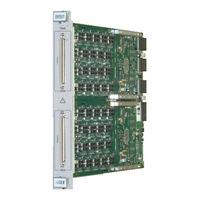Artison 75340-1 Manuals
Manuals and User Guides for Artison 75340-1. We have 1 Artison 75340-1 manual available for free PDF download: User Manual
Artison 75340-1 User Manual (482 pages)
Brand: Artison
|
Category: Network Hardware
|
Size: 11 MB
Table of Contents
-
Chapter 1
36 -
Introduction
36-
-
Front Panel42
-
-
Accessories47
-
Chapter 2
48 -
Installation
48 -
Chapter 3
60 -
-
Chapter 4
66 -
-
-
VXI Bridge67
-
-
Master Clock78
-
System Clock79
-
Test Logic79
-
Timers79
-
Pattern RAM80
-
Record RAM80
-
-
Chapter 5
82 -
-
SFP Basics82
-
-
File Menu86
-
Config Menu87
-
Edit Menu88
-
Execute Menu88
-
Help Menu89
-
-
-
Ltbn Signal95
-
Direction96
-
Group96
-
Invert96
-
IO Max97
-
IO Min97
-
Offset97
-
Slew97
-
OC Sink98
-
OC Src98
-
Delay99
-
Delay Signal99
-
Group [199
-
VXI Triggers99
-
D/R Properties101
-
Invert101
-
Dut_Gnd102
-
Voltage Mode102
-
MFSIG Source103
-
MPSIG Signal103
-
Record Mode104
-
-
Configure Clocks105
-
Master Clock106
-
External Mode107
-
System Clock107
-
External Offset108
-
-
-
Configure Timers109
-
-
Source113
-
Trigger113
-
Test Condition114
-
Edge Test Clear115
-
Input Mode115
-
-
-
Raw Record Basis119
-
Record Offset119
-
Record Type120
-
Timing Mode121
-
Pass Fail Basis122
-
Pass Valid Mode123
-
Over-Current124
-
Drive Fault125
-
Probe126
-
Probe State126
-
CRC Capture127
-
Offset127
-
Probe Data127
-
Probe Button128
-
Compensation129
-
Probe Cal Signal129
-
DC Cal130
-
Attributes131
-
Jump Pass Fail131
-
Phase 3 Mode131
-
CRC Preload132
-
Window 3 Delay132
-
Window 3 Mode132
-
Static State133
-
-
Stimulus Signal135
-
Stimulus Format136
-
Capture Signal137
-
Capture Mode138
-
Static Mode138
-
Properties139
-
Driver Levels140
-
Driver Slew141
-
Termination141
-
Active Load142
-
Channel Connect144
-
Comparator Delay144
-
Hybrid Connect144
-
Channel Mode145
-
All Channels146
-
OC Detect (A)146
-
-
Source150
-
State150
-
Input Bus Source151
-
Connect State152
-
-
Condition154
-
Event154
-
Event False154
-
Event True154
-
-
-
Append159
-
Assign160
-
Edit Data161
-
ASCII Hex168
-
Data Format168
-
Header Format168
-
Binary170
-
ASCII String171
-
-
-
Lc0 - Lc15174
-
Pipeline175
-
Vector Strobe175
-
Set Vector Bits176
-
Source176
-
Input Mode177
-
Set Vector Table177
-
Set Channel Test178
-
Timing Set178
-
Vector Bit Index178
-
Vector Jump Step178
-
Expect179
-
Mask179
-
Internal T0CLK181
-
Timing Set182
-
Gosub Return183
-
Jump Type183
-
Last Step183
-
Sequence Timeout183
-
Jump Condition184
-
Jump Step184
-
Loop Count185
-
Loop Counter186
-
Pass Fail Clear186
-
Step Record Mode186
-
Vector Jump186
-
Timing187
-
Patterns188
-
Pause Signal190
-
Properties190
-
Resume Modifier191
-
Waveform Table192
-
-
Active LED196
-
Idle LED196
-
Burst Error LED197
-
D/R Alert197
-
Errors197
-
Halt LED197
-
Pause LED197
-
Pattern Address198
-
Record Count198
-
Sequence Active198
-
Step Number198
-
Timing Set198
-
-
Channel Drivers199
-
Burst200
-
Execute Step200
-
Halt Mode200
-
Finish Mode201
-
Finish Mode Step201
-
CRC Type202
-
Set Sync202
-
Stop Mode202
-
Event (and Step)203
-
Offset203
-
Sync Number203
-
Length204
-
-
Execute204
-
Execute Idle204
-
Halt204
-
Arm PG205
-
Deskew205
-
Master Reset205
-
Reset205
-
Resume205
-
Stop205
-
Stop PG206
-
-
-
Static Data206
-
Response Delay207
-
Stimulus Delay207
-
Response208
-
Stimulus208
-
Kept Data208
-
Results209
-
Save Results210
-
View210
-
Crcs Display212
-
Sequencer Events220
-
Clear Event223
-
Condition223
-
Enable223
-
Event223
-
Counter Active224
-
Sync Error Step224
-
Status225
-
Alert Text228
-
Clear Event228
-
Condition228
-
Enable228
-
Event228
-
Function233
-
Aperture235
-
Trigger235
-
Initiate236
-
PMU Panel236
-
Results236
-
Channel237
-
Measure Voltage237
-
-
Self Test237
-
Full RAM Test239
-
Driver/Receiver241
-
Meas. Delay242
-
Serial Number242
-
Start Chan242
-
End Channel243
-
Run243
-
Verify244
-
Export247
-
Stop247
-
Trip Temperature247
-
Update247
-
Voltage250
-
Channel251
-
Extforce251
-
Extsense251
-
Monitor Signal251
-
V- Voltage251
-
Channel252
-
Monitor Voltage252
-
Mux Signal252
-
AD Signal253
-
Mode253
-
Negative Signal253
-
Positive Signal253
-
Register253
-
Value254
-
Monitor Signal256
-
-
-
Chapter 6
258 -
-
Voltage Mode259
-
Warm-Up Period259
-
Basic Setup260
-
-
Monitor + ADC265
-
Source/Sink Load268
-
Dvh/Dvl270
-
Cvh/Cvl272
-
Vcom High/Low275
-
Source/Sink Load277
-
Ial/Iah280
-
Chapter 7
284 -
Specifications
284-
Calibration292
-
Front Panel I/O293
-
VXI Interface293
-
Environmental294
-
Chapter 8
296 -
Advanced Topics
296-
-
Step Record Mode301
-
Record Type303
-
-
Definitions322
-
Applications322
-
Halt Examples324
-
Halt Notes325
-
Pause Operations325
-
Pause Examples327
-
Pause Notes328
-
-
-
Appendix A
340 -
-
Block Diagram346
-
Control Logic349
-
Environmental351
-
Calibration357
-
-
DR2 Features358
-
Block Diagram358
-
Control Logic361
-
Environmental363
-
PWR Connector369
-
Calibration370
-
-
Appendix D
372-
Block Diagram372
-
Control Logic375
-
Environmental382
-
Calibration389
-
-
Appendix E
390-
Block Diagram390
-
DR4 Features390
-
Environmental397
-
Calibration401
-
-
-
DR7 Features402
-
Block Diagram402
-
Control Logic406
-
Environmental407
-
Calibration411
-
-
-
DR8 Features412
-
-
Control Logic415
-
Environmental417
-
-
PWR Connector422
-
Calibration423
-
-
-
DR9 Features424
-
Block Diagram426
-
Control Logic428
-
Environmental435
-
DRB Resources439
-
Calibration442
-
-
-
UR14 Features444
-
Block Diagram444
-
Probe I/O451
-
-
Utility Channels463
-
Adc_In467
-
Probe Support467
-
-
Environmental470
-
-
Calibration477
-
-
-
Introduction478
-
AUX Input to TRG479
-
Advertisement
Advertisement
